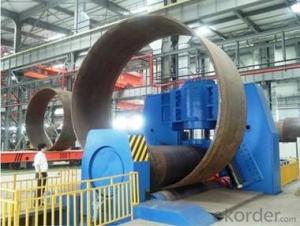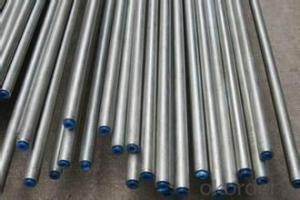ASTM seamless steel pipe for structure use
- Loading Port:
- Tianjin
- Payment Terms:
- TT OR LC
- Min Order Qty:
- 25 m.t.
- Supply Capability:
- 60000 m.t./month
OKorder Service Pledge
OKorder Financial Service
You Might Also Like
Packaging & Delivery
| Packaging Detail: | black painting, plastic caps on both ends, according to customer's requirements |
| Delivery Detail: | 20-30 days |
Specifications
1. Min Order : 20 tons
2.OD: 20mm --508mm
3. WT: 3mm -- 60mm
4.Certification: ISO & API
ASTM A106 SEAMLESS STEEL PIPES FOR STRUCTURE USE
Hot rolled seamless steel pipes
1) Standard: API Standard:ASTM A106.ASTM A53,ASTM A135,ASTM A179,ASTM A214,ASTM A192,ASTM A226,ASTM A315,ASTM A178,ASTM A210,ASTM A333,ASTM A355,ASTM A369,ASTM A334 ASTM/ASME A312/SA312, ASTM/ASME A213/SA213, ASTM A269,ASTM 511,API5L,API5CT, GOST 9940,GOST 9941,JIS G 3459, JIS GS3463, GS3467, JIS G3448, DIN EN 10216-2006(DIN 17458) , DIN EN 10297-2006(DIN 17456) etc.
2) Steel Grade: ASTM A106 GRB,A53 GRB. API 5L GRB,API 5 CT N80,K55,A335 P11.P91,DIN ST52,ST44,ST35.8,ST37,ST42,ST45
3)Outside Diameter:1/2"-20" Or 21.3-508mm
4) Wall Thickness: 3-40mm
5) Application: The products are widely used in fertilizer, petroleum, central-station, boiler, power station, shipping military, chemical industry, environment protection, traffic, metallurgy and mine, printing and dyeing, food industry, medical equipment, and so on.
Production Equipment :
30 sets of Cold-drawn Machinery (Model: 3 ton to 500 ton)
Cold-rolled Machinery: Model LD-30, LD-60, LG-90H (L), LG-159H (L)
Automatic Roller Solution & Annealing Heat Treatment Equipment
18-meter-long Pickling Sin
QUALITY ASSURANCE:
1) Strictly acc. ASTM,DIN,JIS,EN,GOST etc
2) Sample: We are accept your sample requirement
3) Test: Eddy current / hydrostatic/ Ultrasonic/ Intergranular Corrosion or according to customers' request
3) Certificate:API, CE ,ISO9001.2000.MTC etc
4) Inspection: BV,SGS,others is avaliable.
High Quality Package :
1) In bundle with strip;
2) First packing by plastic bag then strip; Details packing please see the picture in the detial description.
3) In bulk
4) Client' requirements
5) Delivery: 1) Container: 25 tons/container for pipe with usual outer diameter. For 20" container the max length is 5.8m; For 40" container the max length is 11.8m.
2) Bulk carrier: It is no requirements to the length of the pipe. But its booking space time is long.
Our Advantages:
1) Fast Delivery: around 10days below 50Metric Tons after sight of Irrevocable L/C or Deposit;(lot of high quality steel pipe in stock)
2) Quality Assured: Strictly acc. To International standard ASTM & BS & EN & JIS, with System ISO certification
3) Good Service: supplied professional technical guide free of charge at anytime;
4) Reasonable Price: to be better support your business;
- Q: How are steel pipes tested for strength and durability?
- Steel pipes are tested for strength and durability through various methods such as hydrostatic testing, non-destructive testing, and mechanical testing. Hydrostatic testing involves pressurizing the pipe with water to check for any leaks or weaknesses. Non-destructive testing techniques like ultrasonic or magnetic particle testing are used to detect any flaws or defects within the pipe. Mechanical testing involves subjecting the pipe to various loads and stresses to assess its performance and resistance to deformation. These tests ensure that steel pipes meet the required standards and are capable of withstanding the intended applications.
- Q: Can steel pipes be used for underground sewage systems?
- Yes, steel pipes can be used for underground sewage systems. Steel pipes are durable, resistant to corrosion, and can withstand high pressure, making them suitable for transporting sewage underground. However, proper protective coating and maintenance are essential to prevent any potential corrosion or degradation over time.
- Q: How many meters per ton of steel tube?
- General scaffolding tube diameter 40mm, specifications specify wall thickness of 3.5mm, the actual wall thickness of 3.2 - 3.4mm.The theoretical weight per meter is 3.85kg and the wall thickness is 3mm.Hence a ton of steel is about 260m.
- Q: What is the process of coating steel pipes?
- The process of coating steel pipes involves applying a protective layer on the surface of the pipe to prevent corrosion and increase its durability. This typically includes cleaning the pipe to remove any contaminants, followed by applying a primer to improve adhesion. The pipe is then coated with a layer of paint or a specialized coating material using a variety of techniques such as spraying, dipping, or electrostatic application. The coated pipe is then cured or dried to ensure the coating adheres properly. This process helps to ensure the longevity and performance of steel pipes in various applications.
- Q: What is the maximum allowable pressure for steel pipes?
- Various factors, such as the type of steel used, the pipe's diameter and thickness, and specific industry requirements, determine the maximum pressure allowed for steel pipes. The American Society of Mechanical Engineers (ASME) offers guidelines and standards for pressure vessel and piping design, which include determining the maximum allowable pressure. For power piping and process piping, ASME B31.1 and B31.3 are commonly used codes, respectively. These codes establish design criteria for different materials, including steel, and provide formulas and charts to calculate the maximum allowable pressure for different pipe sizes and wall thicknesses. The maximum allowable pressure is typically determined based on the pipe's ability to withstand internal pressure without experiencing permanent deformation or failure. It is important to consider other factors, such as temperature, corrosion, and the presence of external loads or stresses, as they may also impact the maximum allowable pressure for steel pipes. Therefore, it is essential to refer to the relevant codes, standards, and engineering calculations specific to the application to ensure the safe and reliable operation of steel pipes under the given conditions.
- Q: How are steel pipes classified based on their end connections?
- Steel pipes can be classified based on their end connections into threaded, socket weld, butt weld, and flanged connections.
- Q: What is the difference between black steel pipe and galvanized steel pipe?
- The main difference between black steel pipe and galvanized steel pipe lies in their coating. Black steel pipe is untreated and has a dark, matte appearance, while galvanized steel pipe is coated with a layer of zinc to prevent rusting and has a silver, shiny appearance. This coating makes galvanized steel pipes more durable and suitable for outdoor use, while black steel pipes are commonly used for indoor plumbing and gas lines.
- Q: Are steel pipes suitable for use in nuclear power plants?
- Yes, steel pipes are suitable for use in nuclear power plants. They are commonly used for various purposes including cooling systems, steam generation, and containment of radioactive materials due to their high strength, durability, and resistance to corrosion.
- Q: What is the maximum operating temperature for steel pipes?
- The maximum operating temperature for steel pipes typically depends on the specific grade of steel used. However, in general, carbon steel pipes can typically withstand temperatures up to 800-1000 degrees Fahrenheit (427-538 degrees Celsius). Other alloy steels, such as stainless steel or high-temperature alloys, can withstand even higher temperatures, ranging from 1200-1500 degrees Fahrenheit (649-816 degrees Celsius) or more. It is important to consult the manufacturer's specifications or industry standards to determine the exact maximum operating temperature for a specific type of steel pipe, as different grades and compositions may have different temperature limits.
- Q: What are the different methods of insulating steel pipes?
- There are several different methods of insulating steel pipes, depending on the specific needs and requirements of the application. Some of the common methods include: 1. Insulation wraps: This method involves wrapping the steel pipes with insulating materials such as fiberglass, mineral wool, or foam insulation. The insulation is then secured with adhesive or tape to ensure a tight and secure fit. Insulation wraps are cost-effective and relatively easy to install, making them a popular choice for many applications. 2. Insulation coatings: This method involves applying a layer of insulating material directly onto the surface of the steel pipe. The coating can be made from materials such as epoxy, polyurethane, or polyethylene. Insulation coatings are ideal for situations where the pipes are exposed to harsh environments, as they provide a protective barrier against corrosion and temperature fluctuations. 3. Insulation jackets: This method involves using pre-fabricated insulation jackets that are designed to fit over the steel pipes. These jackets are typically made from a combination of insulation materials and a weatherproof outer layer. Insulation jackets are commonly used for outdoor or exposed pipelines, as they provide excellent insulation and protection against external elements. 4. Insulation foam: This method involves injecting foam insulation into the cavity between the steel pipe and an outer casing. The foam expands and hardens, creating a sealed and insulated layer around the pipe. Foam insulation is highly effective in preventing heat loss or gain, and it also provides excellent soundproofing properties. 5. Insulation tapes: This method involves using specialized insulation tapes that are wrapped around the steel pipes. These tapes are typically made from materials such as PVC or rubber, which have good insulating properties. Insulation tapes are often used for smaller pipes or joints, as they provide a flexible and easy-to-apply solution. It is important to consider factors such as the operating temperature, environmental conditions, and specific requirements of the application when choosing the appropriate method of insulating steel pipes. Consulting with a professional or insulation specialist can help in determining the most suitable insulation method for your specific needs.
Send your message to us
ASTM seamless steel pipe for structure use
- Loading Port:
- Tianjin
- Payment Terms:
- TT OR LC
- Min Order Qty:
- 25 m.t.
- Supply Capability:
- 60000 m.t./month
OKorder Service Pledge
OKorder Financial Service
Similar products
Hot products
Hot Searches
Related keywords
























